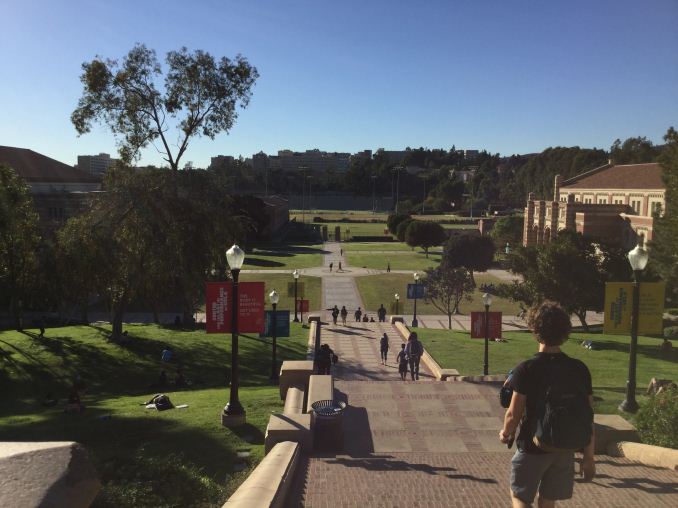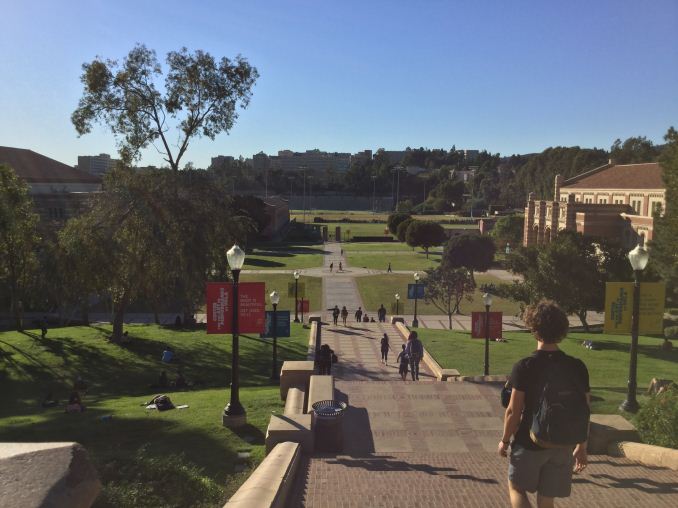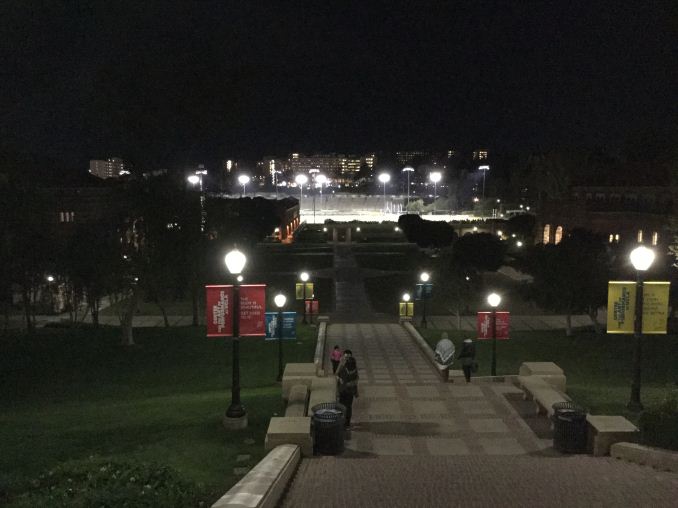The Apple iPad Air 2 Review
by Joshua Ho on November 7, 2014 9:30 AM EST- Posted in
- Tablets
- Apple
- Mobile
- iOS
- ipad Air 2
Camera
For better or worse, the camera on a tablet has become increasingly important. While there was a time when the cameras on tablets were solely used for video calls and similar functions where quality was of relatively low importance, there’s been a clear shift in the other direction. While I don’t think anyone is going to use their tablet as a primary camera, there is a level of convenience that comes with it. I’ve definitely found it to be rather intensely uncomfortable to use a tablet as a camera at all as it’s the furthest thing from inconspicuous. This brings us to the iPad Air 2, which brings the first notable camera change to the iPad line since the iPad 3, as seen below.
| Rear Facing Camera Comparison | |||||||
| Sensor | Resolution | Aperture | Focal Length | ||||
| Apple iPad Air 2 | 8 MP | 3264 x 2448 | f/2.4 | 3.3mm | |||
| Apple iPad Air | 5MP | 2592 x 1936 | f/2.4 | 3.3mm | |||
| Apple iPad 4 | 5MP | 2592 x 1936 | f/2.4 | 4.3mm | |||
| Apple iPad 3 | 5MP | 2592 x 1936 | f/2.4 | 4.3mm | |||
| Apple iPad 2 | 0.7MP | 960 x 720 | f/2.4 | 2.0mm | |||
| Apple iPad mini | 5MP | 2592 x 1936 | f/2.4 | 3.3mm | |||
While the iPad Air 2’s camera does have an eight megapixel output image, it’s important to distinguish this from the iPhone line as the sensor is noticeably smaller than what we see on something like the iPhone 6 and 6 Plus. Instead of 1.5 micron pixels, this gives us 1.1 micron pixels. In addition, the camera lacks PDAF, so focus times will definitely take a fall as a result. On the flip side, this also means no camera hump on the back.
While focus times are one thing, the difference in pixel sensitivity is likely to be the biggest difference. In casual testing, the ISO of the rear-facing camera goes between 25 and 800 ISO, and the front-facing 1.3MP camera will vary between 50 and 2000 ISO. As the tablet lacks optical stabilization, Apple has capped exposure time to a maximum of 1/15 seconds similar to what we see with the iPhone 6.
As one might guess, this difference in sensitivity doesn’t actually make for a significant difference in daytime. While 1.1 micron pixels are relatively small, daytime resolution isn’t all that far off from the iPhone 6. The extremely low sensor gain means that the impact of lower pixel sensitivity isn’t all that significant. It’s clear that the A8’s ISP does a good job of preserving detail while removing noise as we don’t see loss of detail in low contrast areas and noise in general is hard to see outside of the sky.
HDR is also quite good as one might expect, with no perceivable halos or ghosting effects from moving objects.
Unfortunately, in low light we see the weakness of the smaller pixel sizes as a significant amount of noise creeps in. This is especially obvious in preview as noise reduction doesn’t seem to be running at that point. Given the amount of noise in the preview, it’s still quite impressive how Apple manages to make the best of a system that isn’t really designed for low light photography. While a great deal of low-contrast detail is gone, there is a great deal of detail preserved and such images definitely good enough to put online if necessary. I don’t see any major color noise in the image, and luminance noise strikes a good balance between excessive blurring and obvious speckle.
In video, we see a similar pattern. On the whole, the iPad Air 2 benefits from the shared ISP from the iPhone 6’s A8 SoC as the EIS solution is surprisingly effective at suppressing high-frequency shaking. In daytime, detail in video is surprisingly good and quite close to what we see with the iPhone 6 line of devices. The one noticeable weakness is that due to the lack of PDAF, it’s necessary to stop and tap to focus on specific objects to maintain detail. There is auto-exposure, but video performance overall is a bit weaker than what one would get from the best smartphone cameras available. We see the same 17 Mbps bitrate encoded with H.264 high profile here as on the iPhone 6.
The iPad Air 2 also has a slow motion mode, which does 120 FPS at around 31 Mbps encoded with H.264 high profile and plays back at 30 FPS. The resolution is 720p, which is in line with other iOS devices for slow motion.
Once again, in low light we see the weakness in the smaller sensor. There’s a great deal of noise visible throughout the video, although there is an acceptable amount of detail and frame rate remains relatively high.
Overall, it’s hard to really find fault with the camera. While the smaller sensor size and lack of phase-detect focus does make for worse images, the camera can actually take good photos in daytime and usable photos in low light. Video follows a similar pattern as well. As said before, this camera is unlikely to be of any value as a primary camera due to the tablet formfactor. However, for applications that need a camera this should be quite serviceable.































226 Comments
View All Comments
sprockkets - Saturday, November 8, 2014 - link
"Most Android users have no idea.ITunes hasn't been required in years."
Except every ios device has to contact apple to work initially, and either itunes or itunes on the web does this. It's a stupid requirement that apple will never ever let go of.
carloshehe - Sunday, November 9, 2014 - link
You don't have to connect any apple device to iTunes. At all. Ever. You take it out of the box, you turn it on, it asks you a few simple questions and you're on the homescreen.What you're talking about is recovery mode. That's the only time I've seen that.
NEDM64 - Sunday, November 9, 2014 - link
Google Play Services is what?Google's version of "iTunes on the web"...
Really? That "iTunes on the interwebs" is the most retarded thing I haver have read here... But two pages from this, and anyone can see the real problem of this user...
And "iTunes on the interwebs" is welcome, makes a stolen iPhone or iPad worthless, wich if cool, unless you plan to stole one.
akdj - Monday, November 10, 2014 - link
As does Samsung (& Google/AT&T/Verizon/Sprint/Carrier)As does HTC (& Google/AT&T/Verizon/Sprint/Carrier)
As does LG (& Google/AT&T/Verizon/Sprint/Carrier)
As does {insert OEM here} (& Google/AT&T/Verizon/Sprint/Carrier)
....and this DOES include the 'Nexus' lineup. While 'stock Android', it's built by and distributed the largest 'data miners' AND exploiters on the Internet, today. Google. Period
At least with Apple, sure, you definitely 'register' with them ONCE ...From then on, your communication with them is limited by your choices in settings. If title doing nothing wrong, I don't see a reason to help with 'traffic' or a developer improve his app, etc
If I'm doing something wrong, I suppose I would shit those options off. No need to 'phone home' as EVERY Android device does, including my Note3 I enjoy so much
At least Apple's a one shot, you choose deal
In the world of Android, it's a gamble unless you're using Nexus. Then you're 'only' sharing with Google. Everyone else you're dealing with the OEM and the carrier's bloat ...and constant background, unavoidable and incessantly running 'processes'
Anyway, yeah...TL/DR
What did you mean with your quotes?
A) you don't need iTunes EVEN in the beginning to activate your phone. Use a gmail account as your iPhone check in acct
B)‘Most Android users have no idea'
This I disagree with. If argue most ARE aware of this lack of necessity for some time now. Bad thing is you don't ..yet you quoted something you clearly don't understsnd, didn't realize and failed to respond with a 'back up' to your complaint(s)
It's neither a 'stupid requirement'
And Apple only held on to it so it could sync your phone in an expeditious manner! Wireless, broadbamd and 'clouds' have t been here forever.
That said, iTunes eats KIES alive. It's definitely the first thing replaced on my Note updates. Music and media management. Unfortunately, one still has to deal with it for OTA updates
I'll take the iOS 'update' approach (to both apps and full on OS upgrades all day in comparison)
As akways, ymmv
J
robinthakur - Monday, November 10, 2014 - link
Except every Google device has to contact Google to work initially, and all the time thereafter, feeding them yopur usage metrics to make them money. It's a stupid requirement that Google will never ever let go of.There we go, fixed that right up.
extide - Monday, November 10, 2014 - link
Actually you can use an Android device without ever even having a google account. Obviously things like gmail and the play store wont work, but the option is there if you really wanted.akdj - Thursday, November 27, 2014 - link
No different than Android devices using your Gmail information for 'initial contact'There's NO NEED to use iTunes. iTunes on the web. iTunes on your iPhone! There's hundreds of programs to play your media from
And the 'need' to contact Apple, use iTunes or any of the other BS you've been told a couple dozen times now hasn't been the case since 5.0, right?
This is 8.1. So over three years have passed
carloshehe - Sunday, November 9, 2014 - link
In all fairness you do need iTunes still. How will you put all your music in an iPad? Maybe you'll say there are other programs out there you can use, but the fact is you still have to sync it and use some sort of program to put your music.You have 3,000 songs in your computer. You get an iPad. How are you going to put all that music in your iPad?
With Android you can just plug it in and drag and drop your music like the tablet is an external drive.
That being said, Android sucks because it has no tablet apps.
Android tablets are for the very basics. Documents, email, videos. But for anything else, you need an iPad.
akdj - Monday, November 10, 2014 - link
AirDropSync via home sharing (playlists)
Dropbox GDrive OneDrive
iTunes match up to 25,000 songs with ya, everywhere you go ...just $20/year
There's Sooo many options to list, no need to 'sync' your media any longer with your computer physically connected. If you're on you're gime network, feel free to send me a line and I'll walk you through.
All3,00 songs;)
akdj - Thursday, November 27, 2014 - link
I'm blown away by the ignorance hereWow. You'd think half these comments are being made by someone who's never used an iPhone, an iPad. iOS period. Much less a Mac or iTunes ITSELF, no, you do NOT need to 'plug in' to get yiur music. If you've got a hundred thousand, yes. Because a TB or two won't fit. Then, it's as easy as plug in to .mac or PC, sync managment and check the boxes to sync (playlists, artists, all...whatever).
A signficantly better media managment system in aggregate than ANY other in the world
I use Plex. I use Traktor, I edit audio in Audition, video in premier...but like anything else, organization is key. And iTunes has it nailed.
Kies. Sucks ...,and it's the other AIO organizer forced upon you by the biggest (by a HUGE margin) OEM making Android phones. Samsung.
As well, since you know so little about iOS, I assume the same is true with iTunes. It's come a VERY long way since you had to 'connect' your iPhone